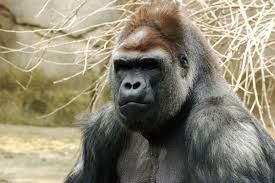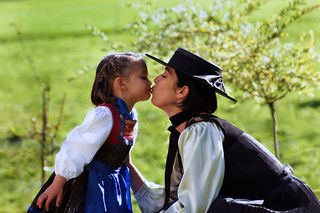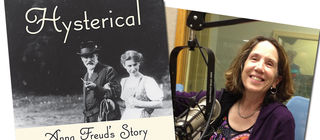Relationships
Intimacy Across Cultures—and Species
Do rats and pgymy chimps dream of electric kisses?
Posted July 11, 2017
Actually, maybe you’ve already heard. In the fall of 2016 a 1993 study about rats wearing polyester won one of Harvard University’s Ig Noble prizes, awarded to bona fide scientific achievements that “first make people laugh, and then make them think.”

In 1993 Egyptian sexologist Ahmed Shafik dressed 75 male rats in different types of pants. Some pants were polyester. Some were a polyester-cotton blend. Some were cotton. Some were wool. The rats had to wear the pants for 12 months. During the course of that year, the rats wearing polyester had far less sex than the other rats. Shafik speculated that the electrostatic potentials of their polyester pants generated electrostatic fields that reduced the sex drives of those rats.
And he may have been right. But something else might have accounted for at least some—and maybe even all—of the reduced sexual activity.
Could it be that no female rat of discernment wants to have sex with a guy wearing polyester? Rather than showing an effect on sex drives of electrostatic fields, did the Shafik study reveal a cultural impediment to intimacy in rats? In rat society, is polyester passé?
And, if cultural differences can ruin a rat’s intimate life, can it also lay waste to a human’s?
Look First to Freud
In his 1930 treatise Civilization and its Discontents, Sigmund Freud suggested that humans need help keeping innate, beastly impulses at bay. He thought humans are more individualistic than communally minded, and he said that their selfish, instinctive urges toward pleasure create psychological trouble when they bump up against civilization's demand for conformity. Freud believed that men and women are hardwired to be as self-centered and destructive as the great apes are, and that it is civilization that forces them to live cooperatively.

That point of view pretty much prevailed until the late 1960s when British zoologist Desmond Morris suggested that Freud might be wrong about humans—and about all great apes. Morris thought that humans aren’t self-centered and destructive by heritage because the great apes aren’t self-centered and destructive. Like Freud, who was somewhat of a genius at catching headlines, Morris was a great front man for his own ideas. He wrote The Naked Ape, which in 1969 was published to much acclaim. In it and in interviews that were part of his book tour he made just enough surprising observations and speculations to—well, to sell 23 million copies. Here are two such observations and speculations.
- Observation: Human women evolved larger breasts and plumper hips than are typical of non-human primate females. Speculation: Walking upright meant that their swollen, red labia were no longer “in men’s face” so to speak. Breasts and buttocks evolved to serve as attractants.
- Observation: Men have the biggest penises of all primates. Speculation: This, too, is a direct result of erect posture. Once everyone was standing up and frankly assessing each other, men, too, needed an attractant.
Unlike Freud, who thought that humans’ bestial heritage is a problem that needs reigning in, Morris proclaimed that humans’ bestial heritage helped both humans and their primate ancestors thrive. Yes, it may have been six million years ago that the human line separated from that of its primate cousins. But at least around 44 million years of primate hardwiring predated that split. Biologically and neurologically, modern humans are much more animal than human. We may be animal culturally, as well. Great apes today live cooperatively in small, isolated tribes that are governed by the tribes’ rigid social hierarchies. Which is to say, even great apes have a civilization, and probably they did long ago.
Seen through this lens, civilization is not, as Freud thought, a recent invention that prevents humans from acting out their most base impulses. Rather it’s an expression and refinement of our early animal culture that, even today, helps us be our best animal selves.
Rather convincingly, Morris argues that the difference between tribal homo sapiens sapiens and today’s homo sapiens sapiens is merely that there are now about 200,00 times more people per square inch than there were way back when. (Actually, he said “100,00 times more,” but the world population has doubled since then.) According to Morris, crowding, not human nature, is the primary problem disrupting modern behavior. Morris likens the crazy behaviors of some of today’s humans to the disturbing, introverted, anti-social behaviors of caged wild animals. Caged chimps smear their excrement, pluck their hair, and bite themselves, sometimes fatally. So can especially harried humans, sometimes.
If Morris was right instead of Freud, the idea that ethics and morality are somehow a result of civilization is hogwash. Instead, they reflect our bestial past. In which case people who extol decency, righteousness, and honor as uniquely human qualities have got their facts all topsy turvey.
What’s more, if civilization itself is characteristic of primates in general, there is no such thing as “pre-civilization” or “pre-culture” regarding human heritage. Any search to understand how culture has enriched or diminished humans’ experience of intimacy shouldn’t bother comparing non-human primate behaviors with human ones.
It might be more helpful to look at intimate behaviors across today’s living cultures.
But “intimate behaviors” is too broad a category to easily consider. Even “kissing” is, because there is a splendid variety of them.
Kissing

A point on which Morris and Freud agree is that kissing may have originated in the mother-infant bond. When adults kiss their infants—or each other—they may be re-exciting the pleasure they once took in being nursed. Morris thinks they may also be re-exciting the pleasure of receiving pre-masticated food spit lovingly into their mouths. Regarding bottle babies, plenty of whom enjoy kissing it—well, it may be that, evolved as we all are from the great apes and their eons of nursing love, we are all hard-wired to like it.
Alas, just as the first nursing human baby neglected to take pen in hand and make note of his or her pleasure at taking in nutrition, no one recorded the pleasure of the first romantic kiss. We do know, however, that lips were eroticized no later than about 5,000 years ago. The Sumerians decorated their lips and eyes with crushed gemstones. Roughly 3,000 years later Cleopatra painted her lips with red pigments squeezed from mashed-up bugs.
Red has survived in lip color ever since.
Why Red?

The color itself seems to be of primal importance to humans. In research published in 1969 anthropologist Brent Berlin and linguist Paul Kay analyzed 110 languages and found that all had names for black and white. Whenever one of the studied cultures had a name for a third color, the color named was red.
Research psychologist Andrew Eliot and social psychologist Henk Aarts later reported that, in their lab, the sight of the color red enhanced the force and velocity of adults’ motor output. They speculated that, to prehistoric humans, that color signaled danger. But women hardly paint their lips red in order to instill fear in men. Might it also signal berries? Fresh meat? And, if so, does red confer a mating advantage? Does it trigger hunger, for example, in both the gut and the groin?
Desmond Morris thinks it’s simpler than all of that. He suggests that the response of male humans to the color red comes from humans’ great ape days, when females had external, swollen, red labia during estrus. As pre-humans evolved and stood upright and the labia became harder for the males to see, breasts and hips on women weren’t all that changed. Women’s lips became extroverted, turning out instead of in. Indeed, so did the lips of all humans. Today, the lips of boys become thinner when they reach adulthood. But girls’ lips don’t. Theirs stay plump until menopause.
Morris is so enamored of his idea of the origin of red, extroverted lips that he calls them “super labia.”
It’s a great term. Whatever you think of Desmond Morris as a theorist, you have to admit he’s a whiz at catchy names.
An Intimate Culture Clash
The first literary reference to human kissing is in Vedic Sanskrit texts from 1500 BC.
The Atharva Veda includes a reference to smelling with the mouth. The Kama Sutra devotes a whole chapter to kissing.
Now, heaven forbid that a young girl from ancient Hindu culture attempts to interpret the kiss of a young 21st century man from North America. Just look:
Here’s how North Americans kiss now. This list of 7 tips is from Bustle.com
- Try an “out of the blue” kiss
- Use a lot of tongue.
- Make them want more.
- Focus on the lips.
- But don’t stick just to the lips.
- Talk about it.
- Remember—Location, location, location.
Here are a few of the many descriptions of kisses from the Kama Sutra
- Throbbing kiss. “When our lower lip moves our lover's lower lip but not the upper."
- Pressed kiss: "When we press our lover's lower lip with much force."
- Touching kiss: “"When our tongue touches our lover's lip and, closing our eyes, our hands touch our beloved's."
What’s perhaps more striking than the difference in kissing across cultures is the literary shift over the centuries from genteel descriptions of a gracious mating dance to somewhat pushy guidelines.
And while it may be easy to imagine that cultural norms about kissing would shift so profoundly over 3500 years, even 120 years can make a difference. The first on-screen, passionate kiss was in a 30-second film made in 1896. It showed a couple kissing and talking intermittently and then fully kissing. Remember, the entire clip of kissing and talking lasted 30 seconds. Still, one observer wrote, “The spectacle of their prolonged pasturing on each other's lips was hard to bear.... Such things call for police interference."
Kissing, Kissing Everywhere
Kissing is rare in the animal kingdom. Yes, giraffes entwine necks. Dogs and cats lick and groom. Some birds nuzzle beaks. So do dolphins. But are those necessarily kisses? And if they are, are they romantic?
Interestingly, common chimpanzees kiss, though not romantically. Most often it’s done as a sort of apology or to share tastes (and information about food). But an endangered subspecies of chimp—pygmy chimps, which are also called “bonobos”—kiss more frequently than common chimps do. What’s more, they use tongues. They are also more likely than common chimps to engage in oral sex. Pygmy chimps have redder lips than common chimps, and the males have larger penises. The males and females mate face-to-face sometimes. And, yes. Pygmy chimps spend more time walking upright than common chimps do.
And humans? If you watch movies, it seems that we kiss almost as frequently as we blow up cars, which is to say “all the time.” But romantic kissing in humans is less universal than one might think.
According to a 2015 study of data from 168 largely pre-industrial human cultures from around the world, the people of only 46% kiss romantically. The ethnographers from the University of Nevada and the Kinsey Institute defined a romantic kiss as “lip-to-lip contact that may or may not be prolonged … not a passing glance but intentional touching of the lips that is more focused and thus potentially more prolonged.” By and large, the researchers found romantic kissing more often in complexly stratified cultures. It’s also more common in colder cultures than in equatorial, Sub-Saharan, hunter-gatherer ones.
What’s the key difference between the warm weather cultures and the cold weather ones? Is it privacy? Cold weather calls for doors and blankets. Warm weather doesn’t.
For what it’s worth, Darwin believed that all human cultures either kiss romantically or have “kissing-like behaviours.” His list of such behaviors included “the rubbing or patting of the arms, breasts, or stomachs” and even an instance of “one man striking his own face with the hands or feet of another.” Yes, it is probably difficult for a North American to see the romance in that last example.
But the term “kissing-like behaviours” may also go a long way to explain an intimate custom of people on the Trobriand Islands near New Guinea. In 1929 anthropologist Bronisław Malinowski reported that, during orgasm, lovers bite off one another’s eyelashes.
Back to Freud … and On to Love

Just imagine: How might one of Freud’s upper middle class Viennese Jews respond to the kissing-like behavior of a Trobriand Islander? What would she do if her eyelashes were bitten mid-orgasm—other than catch her breath and reach for her notebook, write about what just happened, and, of course, bring it up later when in session with Freud?
Now imagine: Margaret Atwood’s fictional character, Offred, fantasizing about really good sex. If you’ve read The Handmaid’s Tale or seen the hit television series based on it, you’ll know that Offred was repeatedly raped by the Commander of the house to which she was assigned, all in an attempt to fertilize her and have her bear a child that would be taken from her and raised by the Commander and his wife. Given that Offred was participating in the sex very much against her will, the sex felt neither passionate nor intimate. Neither was it affectionate. Yet, in the novel, no matter how often Offred was forced to participate in this procreation ritual, she actively missed the sex she and her own husband used to have. Offred had come of age in a culture that placed a high value on deep kisses and the other accoutrements of romantic love, and her captors were clearly of a different culture.
Just how typical is Offred? In the early 1990s, most researchers thought that passionate love was unique to Euro-American cultures. But Bill Jankowiak, who decades later would lead the 2015 team examining the universality of romantic kisses, thought to read the folklore of—and ethnographic studies about—166 primarily pre-industrial cultures from around the world. And in addition to correlating available data, he and fellow researcher Ted Fisher called the authors of individual ethnographic studies and asked whether they’d seen romantic behaviors in the field. Jankowiak and Fisher used what they called a standard definition of romantic love: “Any intense attraction that involves the idealization of the other, within an erotic context, with the expectation of enduring for some time into the future.” In a paper published in 1992 Jankowiak and Fisher reported that couples in 146 of the 166 cultures surveyed behave romantically. Since then, the researchers have re-evaluated their data and added another 5 cultures to the “romance” count. Which suggests that people in 91% of cultures surveyed had the expectations of romantic love that Margaret Atwood’s character Offred did.
But is that necessarily a good thing? The ancient Greeks and Romans both considered romantic love destabilizing. Were they right? Might placing all of one’s emotional eggs in not one basket but in a web of intimate community and family attachments lead to a more stable and rewarding life? Might it offer humans more opportunities to rise to the biological imperative to procreate?
In America today, we extol the idea of matches that are made in heaven and that will last forever. But getting romantically jilted by someone you’ve idealized preposterously hurts like hell. Maybe the pain would be less and the suicide statistics lower if young people didn’t enter exclusive romantic relationships but instead enjoyed a variety of intimate relationships, some sexual and some not. Maybe then, instead of emotionally crumbling when “ghosted” or “dropped,” they would turn to and take pleasure from the other many people who loved them reliably and well.
Cross-Cultural and Cross-Species Intimacy
Would you believe me if I told you that you are sharing intimate space right now with at least hundreds of microscopic mites? Researchers ar North Carolina State University studying a mite called Demodex describe them as fairly good at getting along with humans. They are on your face, but some are probably in your earwax, too. They come in two varieties. The ones called Demodex Folliculorum are tall and thin. The Demodex Brevis are short and fat. Mites are arachnids, and therefore are close cousins to spiders. Don’t worry: Unlike spiders, Demodex won’t defecate on you; they can’t because they don’t have anuses. That said, their abdomens get grotesquely big as their short lives progress. And when they die, they and their excrement degrade right where they land.
But don’t even try to get rid of them. If you’re over 18 they’ll be back in a few days. If you’re way older than 18 you have more now than you did in your younger days. We can’t feel them, see them, or smell them, for example. They don’t bother us in the least, except that sometimes they cause rosacea. And sometimes they make eyelashes itch. They seem to have lived on human faces for at least 200,000 years, which suggests that we don’t bother them, either.
But here's the kicker about intimacy: Without complaint from you, their human hosts, every night by the hundreds, thousands, maybe even millions, Demodex mites crawl out of their hiding places. And what do they do? They have sex all over your face. You are a completely passive participant in their obscene acts.
Wait for it. All of that cross-species lovey-dovey stuff is going to happen again. Tonight.
____

PsychologyToday.com columnist Rebecca Coffey is a science journalist, humorist, and novelist. Her recent novel is the fact-based Hysterical: Anna Freud’s Story, which tells the tale of Sigmund Freud's analysis of his own lesbian daughter. Oprah recommended it in her O! Magazine, and The American Library Association named it a 2015 Over the Rainbow book.
"Journalist Coffey … presents an avidly researched, shrewd, and unnerving first novel that purports to be the lost autobiography of Anna Freud. . . Coffey offers some truly shocking disclosures about the Freud family in this complexly entertaining, sexually dramatic, acidly funny novel of genius and absurdity, insight and delusion, independence and loyalty. Illustrated with archival photographs and backed by a substantial bibliography, this is an electrifying, imaginative portrait of an overlooked historical figure of great significance: fascinating, courageous, and steadfast Anna Freud." — Booklist




